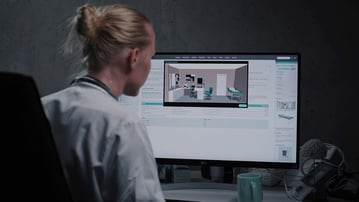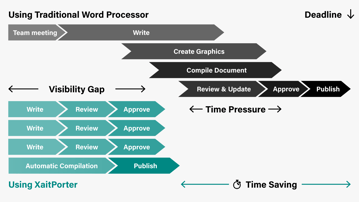From proposals and regulatory filings to technical reports, successful complex document management ensures accuracy and efficiency while eliminating unnecessary roadblocks.
Understanding Complex Document Management
Complex document management refers to the systematic creation, organization, and collaboration on content-heavy files, such as large-scale business proposals, industry-specific reports, or regulatory submissions. These documents require contributions from diverse teams, typically spread across geographies and operating in different time zones.
Unlike simpler documents, complex ones demand more than basic word processing tools. Challenges include:
- Version Control Issues: Preventing conflicting edits and maintaining a single source of truth.
- Dynamic Access Needs: Tailoring access to sensitive data based on contributor roles.
- Compliance with Regulations: Ensuring all content adheres to industry or legal standards.
- Document Retrieval: Quickly finding the correct information for reference or reuse.
- Collaborative Efficiency: Managing multiple contributors without bottlenecks or miscommunication.
These challenges underscore the need for structured solutions capable of simplifying intricate processes while delivering high-quality, polished outputs.
Why Collaboration in Document Writing is Vital
Collaboration unlocks creativity and helps ensure content quality. However, without the right tools, it can easily dissolve into chaos. For example, industries like oil and gas, healthcare, and government contracting deal with detailed applications or proposals. These require input from various departments, from technical experts to graphic designers. Missteps in collaboration—whether due to versioning issues or communication lapses—can lead to compliance failures and missed opportunities.
In the oil and gas sector, licensing applications for drilling rights span hundreds of pages, combining technical data, graphics, and supporting documents. A streamlined document management framework allows companies to:
- Maintain control and a clear overview of progress and status.
- Co-author and collaborate while preserving content and confidentiality.
- Automate workflows, such as task hand-offs and review cycles.
By integrating best practices like transparency, real-time feedback, and consensus-driven reviews, businesses can elevate document quality and increase their chances of success.
Suggested Content



Transitioning from Paper-Based Processes
Many organizations still rely on paper documents, which can be cumbersome to store, manage, and retrieve. Transitioning to digital files offers several advantages:
- Enhanced Document Storage: Digital files require significantly less physical space and can be organized using intuitive document management systems.
- Optical Character Recognition (OCR): Scanned documents become searchable, making document and information retrieval effortless.
- Access Control: Tailored access permissions dynamically protect sensitive information.
- Powered Search: AI-powered systems help users to locate specific content instantly.
Adopting electronic document systems reduces errors, enhances security, and significantly improves relevant information access.
Why Complex Documents Require Purpose-Built Software
Traditional file-sharing platforms and basic word processors lack the capabilities needed for managing large, complex documents. These tools fall short when facilitating transparency, real-time collaboration and secure access. Purpose-built document management software addresses these shortcomings by offering:
- Real-Time Co-Authoring: Multiple contributors can work simultaneously on a single document without overwriting content or creating conflicting versions.
- Workflow Automation: Automate manual coordination, task hand-offs, and review cycles to eliminate confusion, bottlenecks, and delays.
- Centralized Content Management: Store and manage all content in a single repository, ensuring consistency and ease of retrieval.
- Scalable Solutions: Handle projects of any size, from team-level tasks to enterprise-wide initiatives.
How XaitPorter Transforms Complex Document Management
XaitPorter takes complex document management to the next level by offering a cloud-based co-authoring and automation platform designed for large-scale collaboration. Key features include:
- Integrated Collaboration: All contributors work on the same document in real time, whether in the office or across the globe. This eliminates version control headaches and enhances team productivity.
- Dynamic Access Control: Assign permissions at both the document and section level, ensuring confidentiality without hindering collaboration.
- Robust Automation Tools: Streamline workflows by automating task assignments, hand-offs, content updates, document compilation, and formatting.
- Centralized Document Repository: Store, manage, and retrieve all electronic documents from a single source, reducing redundant effort and ensuring accuracy.
- Compliance and Audit Trails: Built-in tools track changes down to the key stroke, helping to ensure compliance, accuracy, and accountability.
XaitPorter is particularly valuable for industries like oil and gas, energy and renewables, government contracting, manufacturing, and field development, where high-stakes documents often determine business outcomes. By simplifying complex workflows and enhancing document quality, XaitPorter empowers teams to deliver polished, professional outputs that meet tight deadlines and stringent standards.
The Future of Document Collaboration
As businesses grow and the need for effective collaboration intensifies, leveraging purpose-built tools like XaitPorter becomes essential. Streamlining workflows, improving document consistency, and ensuring compliance will define the success of organizations handling complex content.









